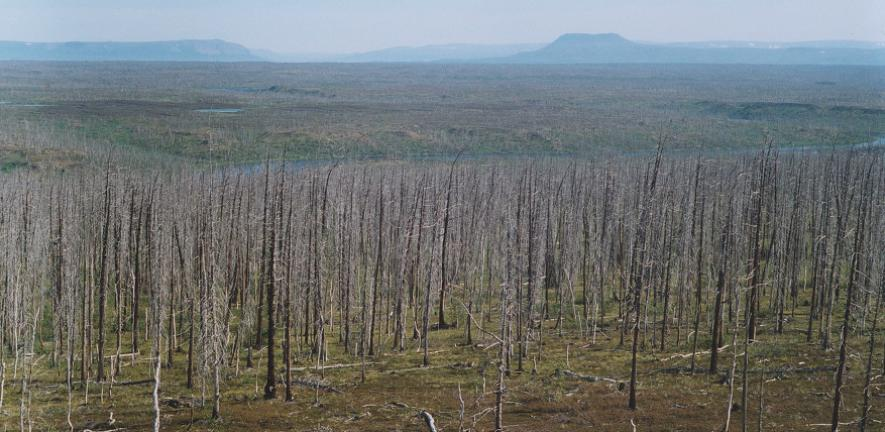Sep 28 2020
The largest-ever analysis of tree rings from Norilsk in the Russian Arctic has demonstrated that the direct and indirect impacts of industrial pollution in the area and beyond are far worse than believed before.
 Forest decline east of Norilsk. Image Credit: Dr. Alexander Kirdyanov.
Forest decline east of Norilsk. Image Credit: Dr. Alexander Kirdyanov.
Now, a group of international scientists headed by the University of Cambridge has integrated ring width and wood chemistry measurements from dead and living trees with soil features and computer modeling to demonstrate that the damage caused by many years of copper and nickel mining has not only ruined the local environment but have also impacted the global carbon cycle.
The level of damage caused to the boreal forest—the Earth’s largest land biome—can be observed in the yearly growth rings of trees close to Norilsk where die-off has extended up to 100 km. The results of the study have been published in the Ecology Letters journal.
Located in northern Siberia, Norilsk is the northernmost city in the world with over 100,000 people, and one of the most polluted regions on Earth. Since the 1930s, intensive mining of the region’s enormous deposits of copper, nickel, and palladium, along with few environmental regulations, has resulted in extreme pollution levels. In May 2020, a huge oil spill has worsened the level of environmental damage in the region.
Since the 1960s, the high level of airborne emissions from the Norilsk industrial complex is responsible for causing the direct destruction of about 24,000 km2 of boreal forest. Furthermore, the surviving trees across most of the high northern latitudes are also suffering. The high levels of pollution lead to declining tree growth, which, consequently, has an impact on the quantity of carbon that can be sequestered in the boreal forest.
But while the connection between forest health and pollution is well established it was not able to describe the “divergence problem” in dendrochronology, or the analysis of tree rings—a decoupling of the width of tree rings because of rising air temperatures observed since the 1970s.
The researchers used the largest-ever dataset of tree rings from both dead and living trees to rebuild the intensity and history of Norilsk’s forest dieback and demonstrated that the amount of pollution released into the atmosphere by smelters and mines is at least partly accountable for the occurrence of “Arctic dimming,” giving new proof to explain the divergence issue.
Using the information stored in thousands of tree rings, we can see the effects of Norilsk’s uncontrolled environmental disaster over the past nine decades.While the problem of sulphur emissions and forest dieback has been successfully addressed in much of Europe, for Siberia, we haven’t been able to see what the impact has been, largely due to a lack of long-term monitoring data.
Ulf Büntgen, Study Lead and Professor, Department of Geography, Cambridge University
The expansion of yearly-resolved and precisely dated tree ring width measurements put together by the study’s first author Dr Alexander Kirdyanov, together with new high-resolution measurements of soil and wood chemistry, enabled the team to measure the extent of the destructive ecosystem damage of Norilsk, which increased considerably in the 1960s.
We can see that the trees near Norilsk started to die off massively in the 1960s due to rising pollution levels. Since atmospheric pollution in the Arctic accumulates due to large-scale circulation patterns, we expanded our study far beyond the direct effects of Norilsk’s industrial sector and found that trees across the high-northern latitudes are suffering as well.
Ulf Büntgen, Study Lead and Professor, Department of Geography, Cambridge University
The group applied a process-based forward model of boreal tree growth, both with and without surface irradiance forcing as a proxy for pollutants, to demonstrate that Arctic dimming has considerably decreased tree growth since the 1970s.
Arctic dimming is an occurrence caused by the increased concentration of particulates in the Earth’s atmosphere, whether from dust, pollution, or volcanic eruptions. This occurrence partly obstructs sunlight, decelerating the process of evaporation and impeding the hydrological cycle.
Global warming is likely to increase the rate of boreal tree growth; however, the team learned that as the pollution levels increased, the rate of tree growth in northern Siberia decreased. They also learned that the levels of pollution in the atmosphere curtailed the ability of the trees to convert sunlight into energy via photosynthesis, and so they were not able to grow as rapidly or as robust as they would in regions with lower levels of pollution.
What surprised us is just how widespread the effects of industrial pollution are - the scale of the damage shows just how vulnerable and sensitive the boreal forest is. Given the ecological importance of this biome, the pollution levels across the high-northern latitudes could have an enormous impact on the entire global carbon cycle.
Ulf Büntgen, Study Lead and Professor, Department of Geography, Cambridge University
Journal Reference:
Kidyanov, V, A., et al. 2020 Ecological and conceptual consequences of Arctic pollution. Ecology Letters. doi.org/10.1111/ele.13611.